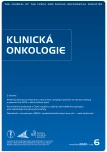First experience in the Czech Republic with perirectal hydrogel injection before radiotherapy for prostate cancer
Authors:
Viktor Vik 1,2,4; Tomáš Novotný 1; Martin Lukeš 1; Petr Holý 1,2,3
Authors‘ workplace:
Urosanté – urologická a andrologická klinika, Praha, ČR
1; Urologická ambulance, IKEM, Praha, ČR
2; Urology dept., Kingston Hospital NHS Foundation Trust, London, UK
3; Urologická ambulance, Gennet, Praha, ČR
4
Published in:
Klin Onkol 2020; 33(6): 440-444
Category:
Original Articles
Overview
Purpose: SpaceOAR® is a Food and Drug Administration approved hydrogel injection used to create space between the prostate and rectum before prostate radiotherapy (RT). This biodegradable hydrogel was not available in the Czech Republic until 2019. We present our first experience as a new established SpaceOAR® centre. We namely focused on technical difficulties with a new procedure and possible medical complications. Methods: We injected SpaceOAR® to 58 patients indicated for prostate RT due to prostate cancer. Prospectively and retrospectively, we monitored the learning curve and complication rate and we assessed the feasibility as an out-patient procedure in the Czech medical environment. Results: The procedure is technically feasible as an out-patient procedure in a urological office. The learning curve with reasonable ultrasound experience and adequate equipment is acceptably short. The number of complications which might be associated with hydrogel injection was very low, with one exception in our centre – ulceration of the rectum. Conclusion: SpaceOAR® injection is a minimally invasive out-patient procedure with expected minimum complications and it is easy to learn.
Keywords:
prostate cancer – radiotherapy – rectal protection – spaceOAR hydrogel system
Sources
1. Global Cancer Observatory 2018 [online]. Available from: http: //gco.iarc.fr/.
2. Syndikus I, Morgan RC, Sydes RM et al. Late gastrointestinal toxicity after dose-escalated conformal radiotherapy for early prostate cancer: Results from the UK medical research council RT01 trial (ISRCTN47772397). Int J Radiat Oncol Biol Phys 2010; 77 (3): 773–783. doi: 10.1016/j.ijrobp.2009.05.052.
3. Serrano AN, Klaman SN, Anscher MS. Reducing rectal injury in men receiving prostate cancer radiation therapy: current perspectives. Cancer Manag Res 2017; 9: 339–350. doi: 10.2147/CMAR.S118781.
4. http: //www.spaceoar.com/assets/LCN-80-3101-001-Rev-C_SpaceOAR-System-10mL-IFU-CAN.pdf
5. Mariados N, Sylvester J, Shah D et al. Hydrogel spacer prospective multicenter randomized controlled pivotal trial: dosimetric and clinical effects of perirectal spacer application in men undergoing prostate image guided intensity modulated radiation therapy. Int J Radiat Oncol Biol Phys 2015; 92 (5): 971–977. doi: 10.1016/j.ijrobp.2015.04.030.
6. Emami B, Lyman J, Brown A et al. Tolerance of normal tissue to therapeutic irradiation. Int J Radiat Oncol Biol Phys 1991; 21 (1): 109–122. doi: 10.1016/0360-3016 (91) 90171-y.
7. Vargas C, Martinez A, Kestin LL et al. Dose-volume analysis of predictors for chronic rectal toxicity after treatment of prostate cancer with adaptive image-guided radiotherapy. Int J Radiat Oncol Biol Phys 2005; 62 (5): 1297–1308. doi: 10.1016/j.ijrobp.2004.12.052.
8. Pollack A, Walker G, Horwitz EM et al. Randomized trial of hypofractionated external-beam radiotherapy for prostate cancer. J Clin Oncol 2013; 31 (31): 3860–3868. doi: 10.1200/JCO.2013.51.1972.
9. Lee WR, Dignam JJ, Amin MB et al. Randomized phase III noninferiority study comparing two radiotherapy fractionation schedules in patients with low-risk prostate cancer. J Clin Oncol 2016; 34 (20): 2325–2332. doi: 10.1200/JCO.2016.67.0448.
10. Hoffman KE, Skinner H, Pugh TJ et al. Patient-reported urinary, bowel, and sexual function after hypofractionated intensity-modulated radiation therapy for prostate cancer: results from a randomized trial. Am J Clin Oncol 2018; 41 (6): 558–567. doi: 10.1097/COC.0000000000000325.
11. D´Amico AV, Manola J, Loffredo M et al. A practical method to achieve prostate immobilization and target verification for daily treatment. Int J Radiat Oncol Phys 2001; 51 (5): 1431–1436. doi: 10.1016/s0360-3016 (01) 02663-3.
12. Prada PJ, Gonzalez H, Menéndez C et al. Transperineal injection of hyaluronic acid in the anterior perirectal fat to decrease rectal toxicity from radiation delivered with low-dose-rate brachytherapy for prostate cancer patients. Brachytherapy 2009; 8 (2): 210–217. doi: 10.1016/j.brachy.2008.11.010.
13. Hamstra DA, Mariados N, Sylvester J et al. Continued benefit to rectal separation for prostate radiation therapy: final results of a phase III trial. Int J Radiat Oncol Biol Phys 2017; 97 (5): 976–985. doi: 10.1016/j.ijrobp.2016.12.024.
14. Seymour ZA, Hamstra DA, Daignault-Newton S et al. Long-term follow-up after radiotherapy for prostate cancer with and without rectal hydrogel spacer: a pooled prospective evaluation of bowel-associated quality of life. [in press]. BJU Int 2020; doi: 10.1111/bju.15097.
15. Aminsharifi A, Kotamarti S, Silver D et al. Major complications and adverse events related to the injection of the SpaceOAR hydrogel system before radiotherapy for prostate cancer: review of the manufacturer and user facility device experience database. J Endourol 2019; 33 (10): 868–871. doi: 10.1089/end.2019.0431.
16. Aminsharifi A, Kotamarti S, Silver D, et al. Major complications and adverse events related to the injection of the SpaceOAR hydrogel system before radiotherapy for prostate cancer: review of the manufacturer and user facility device experience database. J Endourol 2019; 33: 868–871. doi: 10.1089/end.2019.0431.
Labels
Paediatric clinical oncology Surgery Clinical oncologyArticle was published in
Clinical Oncology

Most read in this issue
- Immunostimulatory and anticancer effect of Reishi and Coriol extracts at the level of clinical studies and their implementation in practice
- First experience in the Czech Republic with perirectal hydrogel injection before radiotherapy for prostate cancer
- Stomatitis in mTOR inhibitors treatment and other targeted cancer therapy, possibilities of infl uencing it, and the use of local corticotherapy
- Treatment opinion of rehabilitation in sarcopenia and cachexia for oncological patients
